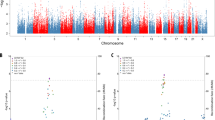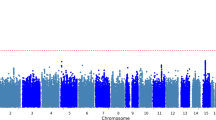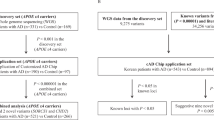Abstract
Peptidylarginine deiminases (PADIs), five isoforms of which have been identified, catalyze the conversion of arginine residues to citrulline residues in proteins. Recent studies have revealed that abnormal activation of PADI2, the gene for which is expressed throughout the nervous system, is likely to be related to the pathogenesis of neuropsychiatric diseases with neurodegenerative processes, such as Alzheimer's disease and multiple sclerosis. Such a progressive neurodegenerative process could be involved in the etiology and/or course of schizophrenia, and PADI2 may be a candidate gene for schizophrenia. To assess whether PADI2 has a role in vulnerability to schizophrenia, we conducted a two-stage case–control association study in Japanese individuals. In a screening population of 534 patients and 559 control individuals, we examined eight single-nucleotide polymorphisms (SNPs) including four haplotype tag SNPs and four coding SNPs in PADI2. There was a potential association of a synonymous SNP in exon 7 with schizophrenia. However, we could not replicate this association in a confirmatory population of 2126 patients and 2228 control individuals. The results of this study suggest that PADI2 does not contribute to genetic susceptibility to schizophrenia.
Similar content being viewed by others
Main
Schizophrenia is a complex genetic disorder that affects approximately 1% of the population worldwide. The pathogenesis of schizophrenia is still unclear; however, a progressive neurodegenerative process could be involved in the etiology and/or course of schizophrenia.1, 2 Peptidylarginine deiminases (PADIs), five isoforms of which have been identified, catalyze the conversion of arginine residues to citrulline residues in proteins.3 PADI2, which is expressed throughout the nervous system, is implicated in the neurodegeneration produced by kainic acid4, 5 and ibotenic acid.6 A recent study revealed an abnormal activation of PADI2 in the hippocampi of patients with Alzheimer's disease.7 A decreased methylation of cytosine residues in the PADI2 promoter may explain the increased synthesis of the PADI2 protein in the white matter of patients with multiple sclerosis.8 Taken together, these findings suggest that disturbances in PADI2 are likely to be related to the pathogenesis of neuropsychiatric diseases with neurodegenerative processes. PADI2 is located on chromosome 1p36.13, which has been suggested to be a candidate region for schizophrenia by some genome-wide linkage studies.9, 10 Thus, PADI2 may be a candidate gene for schizophrenia. Here, to assess whether PADI2 has a role in vulnerability to schizophrenia, we performed a two-stage case–control association study in Japanese individuals.
This study was approved by the Ethics Committee of each participating institute, and written informed consent was obtained from each participant. All participants were unrelated Japanese individuals. The screening population consisted of 534 patients with schizophrenia (281 men and 253 women; mean age 40.1 years (s.d. 14.2) years) and 559 control individuals (297 men and 262 women; mean age 37.3 years (s.d. 10.1) years). The confirmatory population consisted of 2126 patients with schizophrenia (1137 men and 989 women; mean age 47.3 years (s.d. 14.3) years) and 2228 control individuals (1189 men and 1039 women; mean age 46.6 years (s.d. 13.9) years). We conducted a psychiatric assessment of every participant, as described previously.11 In brief, the patients were diagnosed according to the Diagnostic and Statistical Manual of Mental Disorders Fourth Edition (DSM-IV) criteria consensus of at least two experienced psychiatrists. The control individuals were mentally healthy, with no self-reported history of psychiatric disorders, who showed good social and occupational skills.
We examined eight single-nucleotide polymorphisms (SNPs) in PADI2 (Figure 1a). Four haplotype tag SNPs (htSNPs) (rs2235926, rs2076614, rs10788656 and rs2143810) were selected from among 27 SNPs listed in the HapMap database (release no. 20, population: Japanese in Tokyo, minor allele frequency: more than 0.05) as previously described.12 In brief, htSNPs were selected within each linkage disequilibrium (LD) block, which was determined with the criteria D′>0.8 using Haploview v3.32,13 for 90% haplotype coverage with SNPtagger.14 Recently, it was reported that a synonymous SNP in ABCB1 changes substrate specificity, suggesting that the presence of a rare codon, marked by the synonymous SNP, may alter the function of the protein.15 Thus, we also investigated four coding SNPs (cSNPs) (rs2076595, rs3818032, rs2057096 and rs2076615) listed in the JSNP database,16 even though all of these cSNPs were synonymous. All SNPs were genotyped using a TaqMan 5′-exonuclease assay, as previously described.17 To check for typing errors, we genotyped rs2076615 in 88 trios made up of patients and their parents. In addition, this SNP was genotyped in 92 individuals using direct sequencing of PCR products. The sequences of the forward and reverse primers used for amplification are TCTGACGTTGGTCCTTTTCC and AGGCTGACATGGATGGAGAC, respectively. Detailed information on amplification conditions is available on request. Direct sequencing of PCR products was performed using the BigDye Terminator Cycle Sequencing Kit (Applied Biosystems, Foster City, CA, USA) and an ABI PRISM 3130xl Genetic Analyzer (Applied Biosystems).
Genomic structure and linkage disequilibrium (LD) of PADI2. (a) Genomic structure of PADI2 and the locations of the single-nucleotide polymorphisms (SNPs) analyzed in this study. PADI2 has 16 exons (rectangles) and spans approximately 50.7 kb. Horizontal arrow and vertical arrows indicate the transcriptional orientation and locations of SNPs, respectively. (b) LD between markers of PADI2. A block is determined with criteria D′>0.8 using Haploview v3.32. Each box represents the D′ value and r2 value (in parentheses) corresponding to each pairwise SNP.
Deviation from the Hardy–Weinberg equilibrium (HWE) was tested using the likelihood ratio test. Pairwise LD indices (D′ and r2) and haplotype frequencies were determined using Haploview v3.32.13 The genotype, allele and haplotype frequencies of patients and control individuals were compared using the χ2-test. A probability level of P<0.05 was considered to be statistically significant. A power calculation was performed using a Genetic Power Calculator.18 The power was estimated with an α of 0.05, assuming that the disease prevalence was 0.01 and the risk allele frequencies were the values observed in control samples.
In the screening population, the genotype distributions of eight SNPs did not deviate significantly from the HWE in both groups. We found a significant association between a synonymous SNP (rs2076615) in exon 7 and schizophrenia (Table 1; allelic P=0.00014). We observed two LD blocks in PADI2 (Figure 1b). There were no significant associations between the haplotypes of these LD blocks and schizophrenia (data not shown). Next, to confirm the potential association between rs2076615 and schizophrenia, we examined this SNP in the confirmatory population. The genotype distributions were within the HWE in patients, but not in control individuals (P=0.019). The association of rs2076615 with schizophrenia was not replicated in the confirmatory population or in a combined population comprising the screening and confirmatory populations (Table 2). When we genotyped this SNP in 88 trios using the TaqMan method, all genotype data were consistent with Mendelian inheritance. However, genotypes determined by direct sequencing were different from those determined using the TaqMan method in six of 92 individuals.
To the best of our knowledge, PADI2 has not been tested for an association with schizophrenia. The positive association observed in the screening population was probably due to a type I error. In the confirmatory population, the power was more than 0.80 when the genotypic relative risk was set at 1.3 for homozygous risk allele carriers under the multiplicative model of inheritance. Thus, it is unlikely that the negative results in the confirmatory and combined populations were due to type II errors.
We recognize some limitations of this study. First, the genotype distributions of rs2076615 deviated from HWE in the control individuals of the confirmatory population. Deviation from HWE was caused by several reasons, including genotyping errors and population stratification. All genotype data determined by using the TaqMan method in 88 trios were consistent with Mendelian inheritance. However, concordance between genotypes determined by the TaqMan method and direct sequencing was 93.5% in 92 individuals. Hence, we could not exclude the possibility of a false positive in the screening population and a false negative in the confirmatory population because of genotyping errors. As all the participants in this study were of Japanese descent and recruited from the main island of Japan, the likelihood of population stratification seems to be low.19 Second, the sample size of the screening population was moderate, but may not have sufficient power to detect associations between SNPs with small effects and schizophrenia. A power calculation showed that when the genotypic relative risk was set at 1.69 for homozygous risk allele carriers under the multiplicative model of inheritance, the power was 0.54–0.87. Recent systematic meta-analyses of case–control association studies in schizophrenia showed that the average summary allelic odds ratio for 24 variants with nominally significant effects was 1.23.20 In general, it is considered that haplotype analysis provides higher power than single-marker analysis. However, we could not find associations between the haplotypes of two LD blocks and schizophrenia in the screening population.
In conclusion, this study suggests that PADI2 does not contribute to genetic susceptibility to schizophrenia in the Japanese population.
References
Lieberman, J. A. Is schizophrenia a neurodegenerative disorder? A clinical and neurobiological perspective. Biol. Psychiatry 46, 729–739 (1999).
Pérez-Neri, I., Ramírez-Bermúdez, J., Montes, S. & Ríos, C. Possible mechanisms of neurodegeneration in schizophrenia. Neurochem. Res. 31, 1279–1294 (2006).
Vossenaar, E. R., Zendman, A. J. W., van Venrooij, W. J. & Pruijn, G. J. M. PAD, a growing family of citrullinating enzymes: genes, features and involvement in disease. BioEssays 25, 1106–1118 (2003).
Asaga, H., Akiyama, K., Ohsawa, T. & Ishigami, A. Increased and type II-specific expression of peptidylarginine deiminase in activated microglia but not hyperplastic astrocytes following kainic acid-evoked neurodegeneration in the rat brain. Neurosci. Lett. 326, 129–132 (2002).
Asaga, H. & Ishigami, A. Protein deimination in the rat brain after kainate administration: citrulline-containing proteins as a novel marker of neurodegeneration. Neurosci. Lett. 299, 5–8 (2001).
Ahmed, M. M., Hoshino, H., Chikuma, T., Yamada, M. & Kato T. Effect of memantine on the levels of glial cells, neuropeptides, and peptide-degrading enzymes in rat brain regions of ibotenic acid-treated Alzheimer′s disease model. Neuroscience 126, 639–649 (2004).
Ishigami, A., Ohsawa, T., Hiratsuka, M., Taguchi, H., Kobayashi, S., Saito, Y. et al. Abnormal accumulation of citrullinated proteins catalyzed by peptidylarginine deiminase in hippocampal extracts from patients with Alzheimer’s disease. J. Neurosci. Res. 80, 120–128 (2005).
Mastronardi, F. G., Noor, A., Wood, D. D., Paton, T. & Moscarello, M. A. Peptidyl argininedeiminase 2 CpG island in multiple sclerosis white matter is hypomethylated. J. Neurosci. Res. 85, 2006–2016 (2007).
Abecasis, G. R., Burt, R. A., Hall, D., Bochum, S., Doheny, K. F., Lundy, S. L. et al. Genomewide scan in families with schizophrenia from the founder population of Afrikaners reveals evidence for linkage and uniparental disomy on chromosome 1. Am. J. Hum. Genet. 74, 403–417 (2004).
Escamilla, M. A., Ontiveros, A., Nicolini, H., Raventos, H., Mendoza, R., Medina, R. et al. A genome-wide scan for schizophrenia and psychosis susceptibility loci in families of Mexican and Central American ancestry. Am. J. Med. Genet. B Neuropsychiatr. Genet. 144B, 193–199 (2007).
Watanabe, Y., Nunokawa, A., Kaneko, K., Muratake, T., Arinami, T., Ujike, H. et al. Two-stage case-control association study of polymorphisms in rheumatoid arthritis susceptibility genes with schizophrenia. J. Hum. Genet. 54, 62–65 (2009).
Watanabe, Y., Fukui, N., Nunokawa, A., Muratake, T., Kaneko, N., Kitamura, H. et al. No association between the ERBB3 gene and schizophrenia in a Japanese population. Neurosci. Res. 57, 574–578 (2007).
Barrett, J. C., Fry, B., Maller, J. & Daly, M. J. Haploview: analysis and visualization of LD and haplotype maps. Bioinformatics 21, 263–265 (2005).
Ke, X. & Cardon, L. R. Efficient selective screening of haplotype tag SNPs. Bioinformatics 19, 287–288 (2003).
Kimchi-Sarfaty, C., Oh, J. M., Kim, I. W., Sauna, Z. E., Calcagno, A. M., Ambudkar, S. V. et al. A ‘silent’ polymorphism in the MDR1 gene changes substrate specificity. Science 315, 525–528 (2007).
Hirakawa, M., Tanaka, T., Hashimoto, Y., Kuroda, M., Takagi, T. & Nakamura, Y. JSNP: a database of common gene variations in the Japanese population. Nucleic Acids Res 30, 158–162 (2002).
Watanabe, Y., Muratake, T., Kaneko, N., Nunokawa, A. & Someya, T. No association between the brain-derived neurotrophic factor gene and schizophrenia in a Japanese population. Schizophr. Res. 84, 29–35 (2006).
Purcell, S., Cherny, S. S. & Sham, P. C. Genetic Power Calculator: design of linkage and association genetic mapping studies of complex traits. Bioinformatics 19, 149–150 (2003).
Yamaguchi-Kabata, Y., Nakazono, K., Takahashi, A., Saito, S., Hosono, N., Kubo, M. et al. Japanese population structure, based on SNP genotypes from 7003 individuals compared to other ethnic groups: effects on population-based association studies. Am. J. Hum. Genet. 83, 445–456 (2008).
Allen, N. C., Bagade, S., McQueen, M. B., Ioannidis, J. P., Kavvoura, F. K., Khoury, M. J. et al. Systematic meta-analyses and field synopsis of genetic association studies in schizophrenia: the SzGene database. Nat. Genet. 40, 827–834 (2008).
Author information
Authors and Affiliations
Corresponding author
Rights and permissions
About this article
Cite this article
Watanabe, Y., Nunokawa, A., Kaneko, N. et al. A two-stage case–control association study of PADI2 with schizophrenia. J Hum Genet 54, 430–432 (2009). https://doi.org/10.1038/jhg.2009.52
Received:
Revised:
Accepted:
Published:
Issue Date:
DOI: https://doi.org/10.1038/jhg.2009.52
Keywords
This article is cited by
-
Clinical genetic strategies for early onset neurodegenerative diseases
Molecular & Cellular Toxicology (2018)




